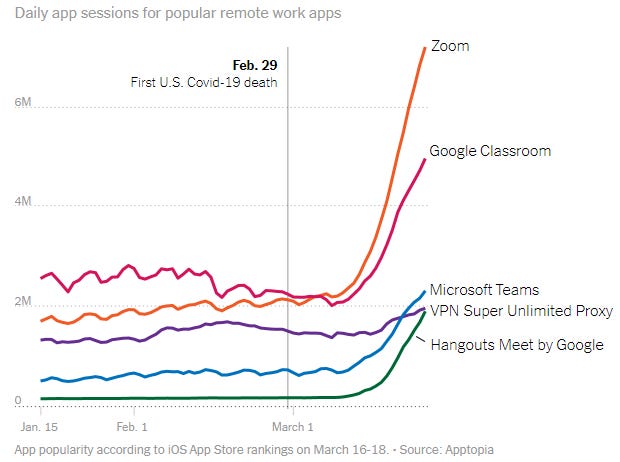Here’s your weekly wrap of technology, innovation, and finance news.
? Alternative Foods
Lab-grown meat could be turned from mush into a nice textured steak by using edible 3D soy scaffolds, a new study finds. The main drawback is the soy “produces a couple of off tastes during cooking”, but apparently you can just cover that with salt. You can find the study in Nature Food.
? Biology
Xenobots are back! I wrote about these living frog-cell robots in Innovation Wrap #24 in January, but now the New York Times dives into how they’re designed and used in greater detail.
All of which makes xenobots amazing and maybe slightly unsettling — golems dreamed in silicon and then written into flesh. The implications of their existence could spill from artificial-intelligence research to fundamental questions in biology and ethics.
“We are witnessing almost the birth of a new discipline of synthetic organisms,” said Hod Lipson, a roboticist at the Columbia University who was not part of the research team. “I don’t know if that’s robotics, or zoology or something else.”
? Health
Here’s an alternative to traditional health insurance that’s gaining share in China: mutual-aid platforms. These platforms function like health insurance, except instead of paying an upfront fee for coverage, the costs of a covered treatment are split between all the members when the cost is incurred. Mutual-aid platforms in China have now attracted 300 million members.
The growth in insurtech – as the use of technology to enhance insurance is dubbed – is disrupting the health care industry in the world’s most-populous nation, which rang up 5.16 trillion yuan (US$727 billion) in medical bills in 2017, according to government data.
“The newly emerged mutual-aid platforms are going to disrupt the health insurance industry in a big way,” said Kenrick Chung, general manager of employee benefits at Realife Insurance Brokers. “These new players offer a protection like an insurance policy while it is much cheaper and does not require the member to pay upfront fee or to do any medical check ups.”
Using video conferencing for doctors appointments is booming in the UK after the NHS told doctors in March to switch to digital consultations.
“We’re basically witnessing 10 years of change in one week,” said Dr. Sam Wessely, a general practitioner in London. “It used to be that 95 percent of patient contact was face-to-face: You go to see your doctor, as it has been for decades, centuries. But that has changed completely.”
A new blood test for detecting cancer is showing promising results. The test is now being trialled on a larger group of people.
The team found that looking at methylation patterns at around 1 million sites in DNA was the most promising approach. Methyl groups are chemical tags added to genes to inactivate them, and DNA from cancer cells has abnormal methylation patterns.
Next, the team trained a machine learning system on blood samples from 1500 people with untreated cancer and 1500 with no cancer diagnoses. They then used the system to analyse 650 blood samples from people with cancer and 610 without.
The machine learning system had a specificity of 99.3 per cent, meaning 0.7 per cent of people were wrongly identified as having cancer. “Specificity is extremely important because you don’t want to raise false alarm in people who are well,” says Seiden.
? Robotics
Google researchers are have taught a robot dog to walk by feeding it videos of real-life dogs. Motion-capture video from a public dataset is fed into a simulator which creates a digital version of the dog, which is then used to train the robot. Their method has led to a gait that’s faster than the fastest gait provided by the manufacturer of the robot.
A robot works quite differently than a biological dog; it has motors instead of muscles, and in general it’s a lot stiffer. But thanks to this translation work, Laikago has learned to move like a real-life canine. Not only that, its learned gait is faster than the fastest gait provided by the manufacturer of the robot—though in fairness it’s not yet as stable. The new system could be the first steps (sorry) toward robots that learn to move not thanks to exhaustive coding, but by watching videos of animals running and jumping.
The WSJ looks at more robots that are being used to help prevent the spread of coronavirus. They’re mostly cleaning robots.
? Gaming
Mobile game downloads increased by 20% in Q1 as more people stayed home, according to App Annie.
If you’re new to gaming and wanted to try it out, the NY Times wrote a guide to help you get started.
ESPN2 aired 12 hours of esports on the weekend to make up for reduced traditional sports coverage. The NBA 2K tournament brought together 16 NBA players to compete in a 16-bracket event.
? Artificial Intelligence
Australian startup Cortical Labs is building miniature disembodied brains using real, biological neurons embedded on a specialised computer chip. This does sound like science-non-fiction so I wasn’t surprised when I saw my friends at Blackbird Ventures had backed the company.
Cortical Labs, based in Melbourne, is hoping to teach these hybrid mini-brains to perform many of the same tasks that software-based artificial intelligence can, but at a fraction of the energy consumption. Currently, the company is working to get its mini-brains—which so far are approaching the processing power of a dragonfly brain—to play the old Atari arcade game Pong, Hon Weng Chong, the company’s cofounder and chief executive officer, said.
…
Using real neurons avoids several other difficulties that software-based neural networks have. For instance, to get artificial neural networks to start learning well, their programmers usually have to engage in a laborious process of manually adjusting the initial coefficients, or weights, that will be applied to each type of data point the network processes. Another challenge is to get the software to balance how much it should be trying to explore new solutions to a problem versus relying on solutions the network has already discovered that work well.
An AI system was trained to translate thought into sentences using a limited vocabulary of 250 words, which can be useful for helping people who can’t talk to communicate.
Costas Spanos from UC Berkeley thinks you can save energy costs in the office by letting AI control the lights and temperature while it learns from tracking your employees.
By comparison, a proposal to automate lights and AC with deep learning looks rather quaint. But there are huge efficiency gains to be had from how we use indoor spaces—provided we don’t rely on humans to turn out the lights. “We can try teaching people to change their behaviors,” Spanos says. “But I don’t think that’s going to be effective. You’re just going to have to automate around it.”
⚡ Other Snippets
Some parents have taken to using Trello to manage their homeschooling plans during the coronavirus outbreak.
How has the virus changed the way we use the internet? It looks like Facebook, Netflix, and Zoom are winners.
Speaking of Zoom, they had a rough week with a lot of scrutiny over their security and privacy practices. Some are were fair, and some were not — I thought this was a reasonable summary (but note I do own the stock). Zoom also revealed that they jumped from 10 million daily active users to 200 million daily active users in the 3 months from December to March. Forbes also profiled Eric Yuan, Zoom’s founder and CEO, and CNBC profiled the company’s rise to the top.
Personal plug: My fund ended up having a pretty good March, relatively, with a decline of 2.5% for the month, a gain of 6.5% for the quarter, and a gain of 20.4% for the year (all in AUD and after fees).













